August Fungi Focus : Pale Brittlestem, Candolleomyces candolleanus / Psathyrella candolleana
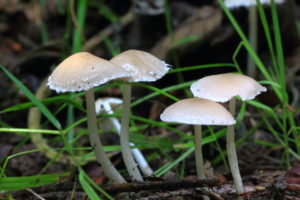
There’s usually a distinct seasonal change around this time of year. Typically, we get a scorching hot July while the kids are at school with their heads down for exams, only for the temperatures to drop and the clouds to set in as soon as they break up for the summer hols. I could almost time the end of the school year by the appearance of this month’s mushroom of focus, as the first heavy summer rains prompt mass flourishings of Pale Brittlestems (Candolleomyces candolleanus), sometimes known as the Crumble Cap, or Common Crumble Cap. Alongside Sulphur Tufts, Fairy Inkcaps, Collared Parachutes, and the (related by common name at least) Trooping Crumble Cap, the sight of this species for me really seems to mark the arrival of the bona-fide mushroom season, just at the point where boredom with rusts, crusts and ascomycetes is beginning to set in.
Except this year is slightly different. We’ve recorded our hottest temperatures of all time in the UK, with the thermometer breaching the 40C mark here in the part of Kent where I’m based, and the past few weeks have been spent awaiting the long overdue summer deluge to bring a climax to the heatwave. But the rains haven’t come. The ground is parched and bare. I literally can’t remember the last time it rained.
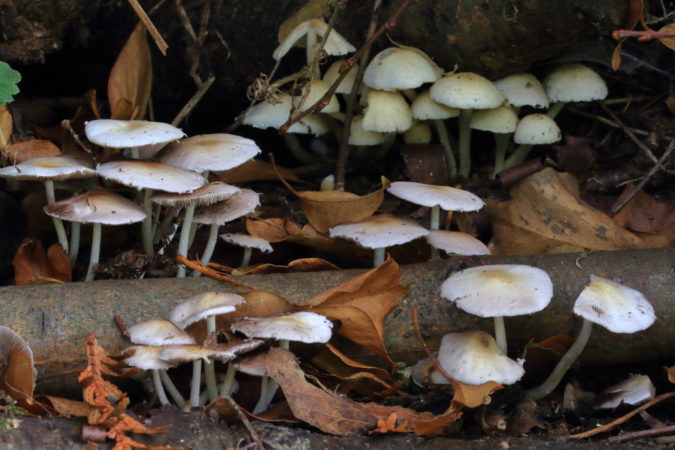 Pale Brittlestem
Pale Brittlestem
One would suspect this to be a pretty bad situation for fungi. However the shortening hours of daylight in August and the consequently cooler nights have a positive knock on effect in that dew begins to fall more easily, and in the shady stillness of the woods, first thing in the morning at least, things are relatively cool and damp at ground level. And so while I’ve set out on my recent woodland wanderings with lowered expectations, I was delighted to find just a few days ago that the current drought situation hasn’t put pay to the appearance of this herald of fungal things to come. Yes, the Pale Brittlestems have arrived, and if perchance it does rain before this post goes online, I’d wager there’ll be a whole lot more of them appearing.
This commonplace species is so generically mushroom-looking that while it provides quite a challenge to identify for beginners, once you’ve become more familiar with it, you should pretty much recognise it with some ease. In this sense, it is rather like the similarly nondescript Clouded Funnel (Clitocybe nebularis), in that it varies quite dramatically in form and colour throughout its various stages of growth.
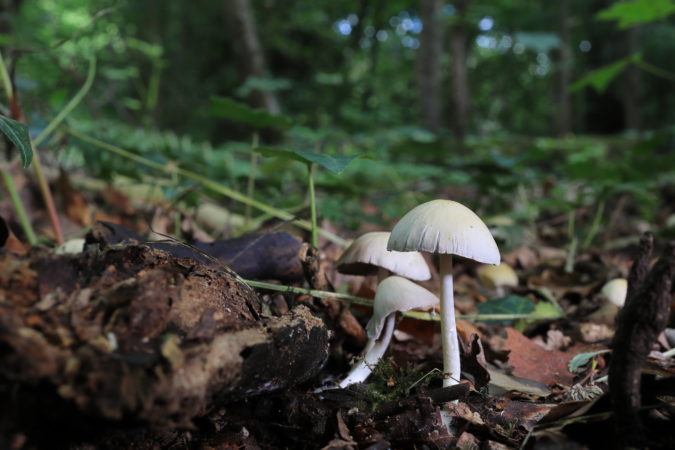 Pale Brittlestem
Pale Brittlestem
In terms of habitat, it too is saprobic, growing either singly or in scattered groups on organic debris such as leaf litter, around rotting tree stumps or small bits of buried wood in parks, gardens and, of course, woodlands. When I describe it as common, it is one of those species that I see pretty much every year and have found in a range of different locations. Interestingly, I’ve often found it by entrances to woods or at the side of paths running through them. I recently identified this fungi growing around a hydrangea in someone’s garden. They asked how to get rid of it, but I queried why anyone would want to do that, pointing out that they’re totally harmless by any definition of the word – you could even eat them, if that’s your bag, although probably only the most desperate would bother. By feeding off dead organic material (presumably small twigs in this instance), breaking it down and returning the carbon and other nutrients to the soil, it can only be a good thing for the garden.
Lets look at the hallmarks of this particular little mushroom. First of all, it should come as little surprise to learn that the Pale Brittlestem has a brittle stem (or rather stipe, in mycological parlance). Bend it, and it will snap. Run your fingernail along its edge to cut it lengthwise and you’ll notice it is hollow, like a dandelion stalk. It also bares a distinctive pattern that I always find useful for identification, looking a little like a pure white scurfy snakeskin. This pattern is formed by the remnants of the veil, or velum – the membrane from inside which the immature fruit body develops in and emerges from. Occasionally, this stem has a ring around it, although I’ve never seen this myself.
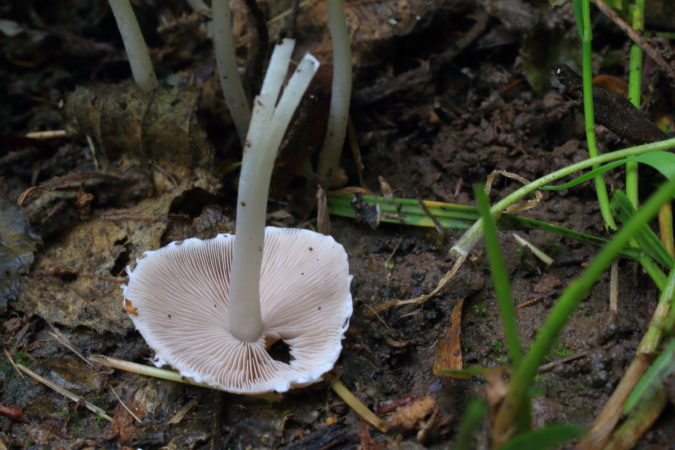 Pale Brittlestem
Pale Brittlestem
The flesh in the cap is also thin and delicate and breaks easily. The gills underneath are relatively tightly packed and start out white, but like a supermarket mushroom, darken as the spores mature within them through pinks and greys to a dark brown. Lay the cap on a white piece of paper for a few hours and you’ll get a dark brown spore print.
The Pale Brittlestem is a member of the Psathyrellaceae “family of dark-spored agarics that generally have rather soft, fragile fruiting bodies”, which also include the coprinoids, or inkcaps, such as the Shaggy Inkcap. However, another key identification feature here is that the gills don’t auto-digest and melt away into a black ooze like those of these species.
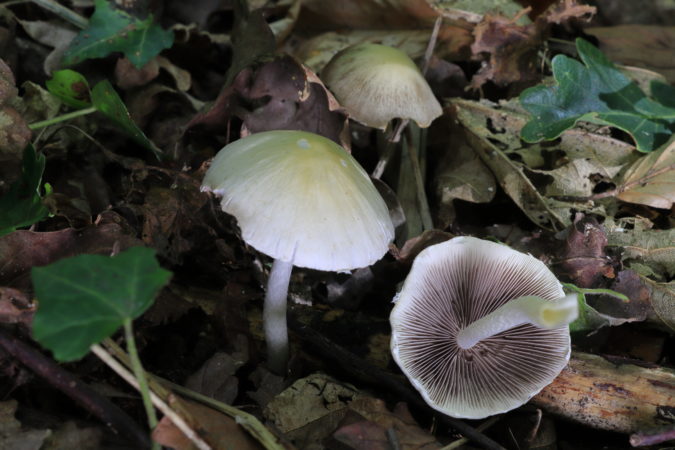 Pale Brittlestem
Pale Brittlestem
The cap starts out dome-shaped and golden-brown in colour and flattens out to a diameter within the range of 3-6cm when fully expanded, while also fading to a pale near white colour like your typical shop-bought button mushroom but with slight yellow tinges. That’s right – the golden-brown dome-shaped mushroom that may be sitting amongst or not far from the group of thin-flesh mushroom-coloured and mushroom-shaped mushrooms is most likely the same mushroom. Geoffrey Kibby, in his Mushrooms and Toadstools of Britain and Europe vol 3 writes that when young, they can also be “reddish ochre”, and to further confuse matters, the caps are also hygrophanous – which means they range dramatically in colour and darkness depending on how wet or dry they are, and sometimes two tones can be present in the same cap.
This cap does however present some clues amongst the confusion, mainly in the form of the tatty fringes around the margin, which like the patterns on the stipe are the remnants of the velum and also appear as flecks across the cap’s upper surface. I had a vague idea in my mind that these fringes were what gave this mushroom it’s latin name, Candolleomyces candolleanus – that it had something to do with candlewick bedspreads or lampshades or suchlike. It turns out, however, that there is not even the remotest of links, and that this species was named in honour of the Swiss botanist Augustin Pyramus de Candolle (1778-1841).
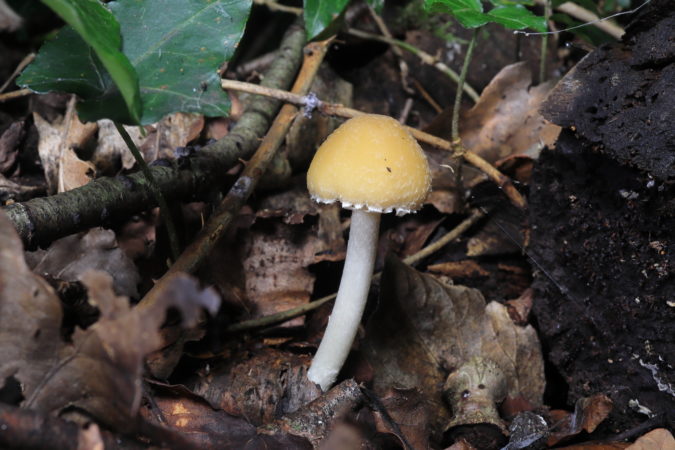 Pale Brittlestem
Pale Brittlestem
While we are on the subject of Latin names, it is worth pointing out that until very recently Candolleomyces candolleanus was known as Psathyrella candolleanus – so recently in fact that the encyclopedic Fungi of Temperate Europe (2019) still refers to it by this earlier name, as does its entry on the First Nature website and even that of the British Mycological Society as of this time of writing.
Psathyrella was a sizeable genus that was used to encompass a vast range of the small saprobic mushrooms linked by brittle stipes, dark spores and non-dissolving gills. Many of the Psathyrellas tended to be very difficult to pinpoint down to species level due to the variability of cap shape and colouration depending on their age and environmental humidity on the one hand, and the overlap of these visible features between various different species on the other. They are the type of fungi that amateur foragers might apply the term LBM (“Little Brown Mushroom”) to. Even microscopic inspection of spores and other hidden features revealed the difference between many of the Psathyrellas was often pretty hazy.
As the American mycologist Michael Kuo wrote on MushroomExpert.com in 2011, “the traditional genus “Psathyrella” is headed for some pretty big changes.” DNA analysis has revealed recently that many of those thought closely related are in fact anything but, and the Psathyrella genus has undergone a massive taxonomic overhaul.
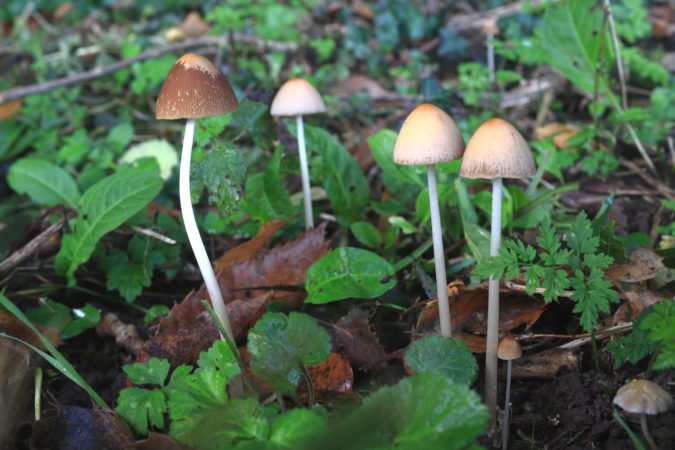 Conical Brittlestem (Parasola conopilus)
Conical Brittlestem (Parasola conopilus)
An illustrative example would be the Conical Brittlestem, which also has a hygrophanous cap that can be dark brown and two-toned when fresh or damp, and is noticeably paler when old and dry. The Conical Brittlestem has moved from being Psathyrella conopilus to Parasola conopilus, emphasising how it is by no means as closely related to the Pale Brittlestem as might be assumed from its physical appearance.
Just to further confuse matters, Geoffrey Kibby’s entry for Candolleomyces candolleanus describes it as “A species complex yet to be sorted out” – in other words, this species-level identification of the Pale Brittlestem seems to encompasses a range of genetically different organisms that are so similar in terms of observable features that the boundaries between them are very blurred.
It is true, just as there are many mushroom species that look so similar to Candolleomyces candolleanus that you’d be forgiven for identifying them as such (the Clustered Brittlestem or Psathyrella multipedata being one such example), the variability of the Pale Brittlestem’s appearance is also marked enough for the potential to confuse it with other species.
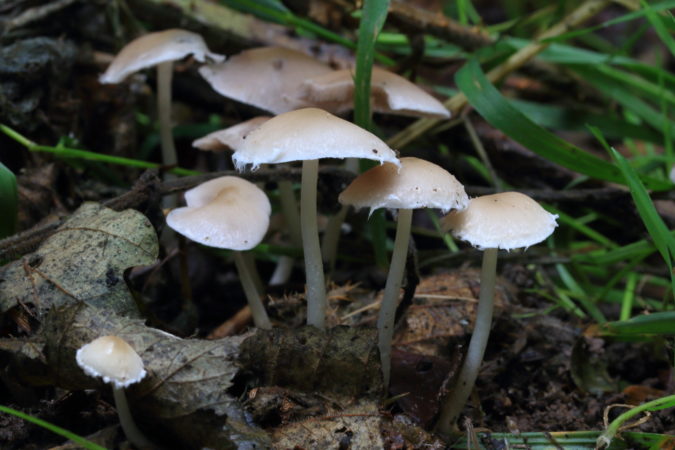 Pale Brittlestem
Pale Brittlestem
Let us leave it to the molecular scientists and the hardcore mycological experts to quibble about the minutiae of Brittlegill taxonomy. I think the Pale Brittlegill provides a wonderful example of an instance where it would be quite forgivable for the average nature lover to ditch the Latin and not to bash ones brains out over more thorough identifications.
If one follows the basic guidelines in this post, I do however think it should be easy to put the name Pale Brittlegill to this common species that you should be seeing a lot more of around now, or at least get somewhere close to an identification.
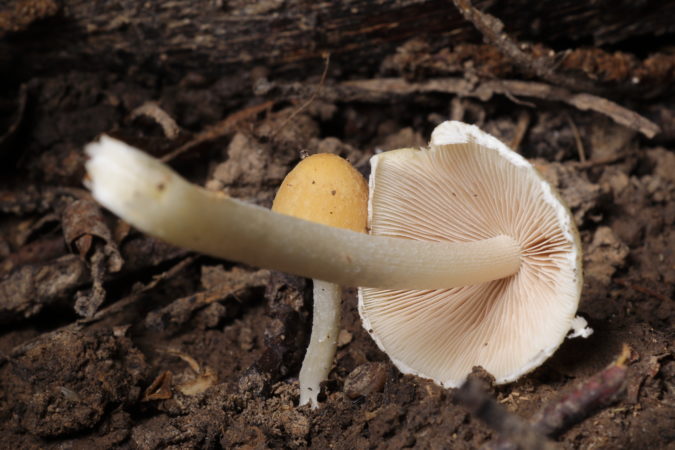 Pale Brittlestem
Pale Brittlestem
Comments are closed for this post.

What a fantastic piece of Data I have been interested in Fungi for years (Amateur) and this year for the first time came across a woodland floor with Hundreds possibly thousands of these Fungi in colour changes of cap and gills, so a bit confusing. Your article has explained everything and I am most grateful for the chance to read it
Robert Hall
Robert Hall
17 September, 2022